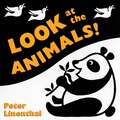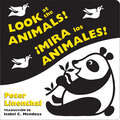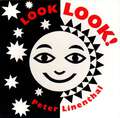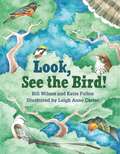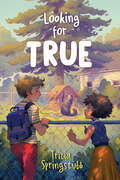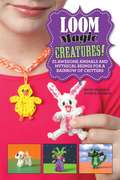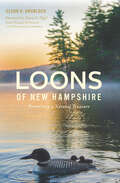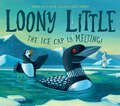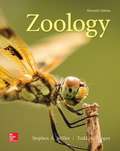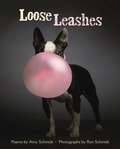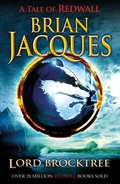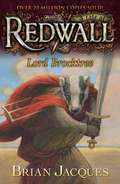- Table View
- List View
Look at the Animals
by Peter LinenthalBirds sing, zebras run, and whales spout in this delightful follow-up to Look Look!, which has sold nearly 50,000 copies. Bold, black-and-white illustrations offer the clean shapes and strong contrasts best suited to young babies&’ developing minds.The warm, simple text makes this a perfect first book for sharing with a little one who&’s just beginning to look and learn. An ideal shower gift that&’s sure to become a favorite with baby.
Look at the Animals!/¡Mira los animales! (Bilingual English-Spanish Edition)
by Peter LinenthalGracias al arte de alto contraste en blanco y negro, este libro resulta perfecto para los bebés que apenas comienzan a observar y aprender sobre los animales.High-contrast black-and-white art makes this the perfect book for babies just beginning to look and learn about animals.¡Mira!Los pájaros vuelan, las ballenas soplan, los cachorros juegan ... odo para deleitar al bebé.Gracias al arte de alto contraste en blanco y negro, este libro resulta perfecto para los bebés queapenas comienzan a observar y aprender sobre los animales.Look!Birds fly, whales spout, puppies play ... all for baby&’s delight.High-contrast black-and-white art makes this the perfect book for babies just beginning to look and learn about animals.
Look! (I Like to Read)
by Ted LewinLook! An elephant eats. Look! Giraffes drink. Look! A warthog digs. A gorilla hides, wild dogs listen, zebras run, monkeys sit, hippos splash, and a rhino naps. Each line of text is illustrated by a two-page spread with a beautiful painting of an animal Ted Lewin has seen on his journeys to Africa. At the end of the story, a boy reads, plays, and dreams, surrounded by toy animals that represent each of the real ones. This book encourages children to observe, enjoy, and appreciate the natural world. Guided Reading Level D.
Look, Look!
by Peter LinenthalStriking and stylish, Look Look! is the ideal first board book for babies just beginning to look and learn and a perfect gift for little hands.Look, look! Children run, fish swim, stars shine . . . all for baby's eyes to see. This sturdy board book, full of high-contrast black-and-white cut-paper art perfect for staring at, is just the thing for the eyes of the youngest babies. A few words in curving red type on each spread describe the scenes—a car races, a cat stretches, flowers bloom—and extend the book's age appeal so that it will be fascinating to older babies, too.
Look, See the Bird!
by Bill Wilson Katie FallonLook, See the Bird! is a beautifully illustrated children's book which seeks to not only promote curiosity in children about the natural world around them, but also to establish the universal quality of having a connection with nature. Look, See the Bird! follows children in a variety of locations, all of whom are learning about local birds and their habits. Beginning with Ruben and his sister Maria, who have decided to spend their day bird-watching in the coffee plants of their Nicaraguan farm, the story wings towards locations as far removed as Alabama and Ontario, lighting down briefly along the way as children the world over join with Ruben and Maria in spirit, looking for birds in their own backyards. Each time, the question is asked by one child to another: "Look! See the bird?" And each time, the children are treated to the sight of a majestic bird native to their home. This unifying question joins the children on the page with the children holding the book, inviting them to look outside, and see what they can see!
Look-Alike Animals
by Robin BernardExplains the differences between such animal look-alikes as cheetahs and leopards, frogs and toads, crocodiles and alligators, seals and sea lions, and rabbits and hares.
Looking Ahead: Guide Dogs For The Blind
by Paula HarringtonHave you ever seen a handsome, intelligent dog wearing a leather harness and leading a blind person at a steady clip along a busy city street full of obstacles? That kind of training, trust and teamwork doesn't just happen It happens at Guide Dogs for the Blind of San Rafael, California. The story begins in 1941 in Los Gatos, ironically, a city named for cats. It is the story of determined, strong-minded pioneers who wanted a West Coast school that would train newly blinded servicemen who came home during and after World War II to achieve greater mobility and independence. It is the story of dogs--"Blondie," "Frank of Ledge Acres," "Abby," "Lee," "Dugan" and "Mozart"--of 4-H puppy raisers and adult volunteer puppy testers, of instructors and veterinarians. It is the story of the seven six-week-old yellow Labrador retriever puppies on the cover of this book. There are dogs everywhere on the Guide Dogs campus, and there are dogs everywhere in this book. They range from silly puppies who trip over their own paws to dignified adult Guide Dogs. This is a success story, one filled with courage, optimism, hope, humor and hard work, from dogs, instructors, staff, students and graduates alike. It is the story of a struggling school that started in a rented farm house with one trainer, two students and donated dogs, a school that today has graduated more than 6,000 teams of blind person and Guide Dog. It is the story of a group of graduates that includes people from all walks of life, from ranchers to college students, homemakers, attorneys and musicians.
Looking for Juliette (Investigators of the Unknown #2)
by Janet Taylor LislePoco is horrified when Angela&’s cat disappears while under her watch. Is magic involved?Together, Angela, Poco, and Georgina have investigated some peculiar happenings. They are just on the verge of a major magical breakthrough when Angela&’s father moves to Mexico, taking Angela and breaking up the trio of friends. As consolation, Angela gives Poco her cat, Juliette, to care for and talk to while she&’s gone. Talking to animals is Poco&’s special skill, but no words can stop Juliette from running into the street in front of a car. Though she survives the accident, Juliette vanishes, and it will take a miracle to find her. With the help of Walter Kew, a secretive boy in her class, and his Ouija board, Poco scans the neighborhood. When all mystical signs point to Miss Bone, the strange old spinster who&’s been taking care of Angela&’s house, Poco is quick to face her fears. She&’ll do anything for Angela—and for Juliette. This ebook features a personal history by Janet Taylor Lisle including rare images and never-before-seen documents from the author&’s own collection.
Looking for True
by Tricia SpringstubbWhen two unlikely friends bond over shared compassion for a bereft but lovable dog, they learn what it truly means to find a sense of belonging and identity. 11-year-olds Gladys and Jude live in the same small, rust belt town, and go to the same school, but they are definitely not friends. Gladys is a tiny, eccentric, walking dictionary who doesn&’t hesitate to express herself, while Jude likes to keep his thoughts and feelings to himself. But they both agree that a new dog in the neighborhood is being mistreated by its owner. Gladys would like to do something to help while Jude is more resigned to the situation until the dog (who Gladys has named True Blue) disappears. They hatch a plan to find her and once they do, realize they have a problem: Gladys&’s father is allergic and Jude&’s mother hates dogs. There is no way they can bring her home. They hide True Blue in an abandoned house on the edge of town, but as their ties to the dog--and to one another--deepen, so does the impossibility of keeping such a big secret. Yet giving True up will break all three of their hearts. Told in alternating voices set in a small, rust-belt town, True Blue is a story about family, identity, and finding friends in unexpected places.
Looking for Winston (The Adventures of Sophie Mouse #4)
by Poppy GreenSophie Mouse’s little brother goes missing in the fourth book of The Adventures of Sophie Mouse.Sophie’s brother Winston really wants to help Sophie and her friends build a fort at Butterfly Brook. But Sophie doesn’t want her six-year-old brother hanging around, and she tells him he’s too little to join. Soon after Winston leaves, Sophie realizes that they could use his help after all. So she returns to tell Winston he’s welcome to come along—but Winston is nowhere to be found! Will Sophie find her little brother?With easy-to-read language and illustrations on almost every page, the Adventures of Sophie Mouse chapter books are perfect for beginning readers.
Loom Magic Creatures!: 25 Awesome Animals and Mythical Beings for a Rainbow of Critters
by Becky Thomas Monica SweeneyFrom the authors of bestselling titles Loom Magic! and Loom Magic Xtreme! comes Loom Magic Creatures!: 25 Awesome Animals and Mythical Beings for a Rainbow of Critters. <P><P>According to the New York Times, Rainbow Looms are the hottest trend on the market, and it is continuously growing in popularity. New and crazy designs are being created every day, and now you can astound all of your friends with these fun and wacky critters, including:MedusaButterflyPenguinCrabDogBunnySpiderPigGingerbread manParrotDragonPrincessSantaRobotCatAnd many more!This collection of never-before-seen projects will have all of your friends begging for your Rainbow Loom secrets!
Loon Lessons: Uncommon Encounters with the Great Northern Diver
by James D. ParukThe nature of the common loon, from biology to behavior, from one of the world&’s foremost observers of the revered waterbird Even those who know the loon&’s call might not recognize it as a tremolo, yodel, or wail, and may not understand what each call means, how it&’s made, and why. And those who marvel at the loon&’s diving prowess might wonder why this bird has such skill, or where loons go when they must leave northern lakes in winter. For these and so many other mysteries, Loon Lessons provides evolutionary and ecological explanations that are curious and compelling. Written by one of the world&’s foremost experts on the subject, the book is a compendium of knowledge about the common loon and an engaging record of scientific sleuthing, documenting more than twenty-five years of research into the great northern diver.James D. Paruk has observed and compared loons from Washington and Saskatchewan to the coasts of California and Louisiana, from high elevation deserts in Nevada to mountain lakes in Maine. Drawing on his extensive experience, a wealth of data, and well-established scientific principles, he considers every aspect of the loon, from its plumage and anatomy to its breeding, migration, and wintering strategies. Here, in the first detailed scientific account of the common loon in more than thirty years, Paruk describes its biology in an accessible and entertaining style that affords a deeper understanding of this beautiful and mysterious bird&’s natural history and annual life cycle.
Loons (Nature's Children)
by John WoodwardHow many different kinds of loons are there? What do loons eat? Where do loons live? Find the answers to these questions, and learn much more about the physical characteristics, behavior, habitat, and lives of loons.
Loons of New Hampshire: Preserving a Natural Treasure (Natural History)
by Glenn A. KnoblockNoted for its stunning plumage and haunting cries, the common loon is an iconic symbol of nature in the Granite State. Once a familiar site on local ponds and lakes, by the early twentieth century their numbers had dwindled due to human activity. By the 1970s less than two hundred remained. It was only with the formation of the Loon Preservation Committee in 1975 by pioneer conservationist Rawson Wood that the plight of loons in New Hampshire changed for the better. Author Glenn Knoblock, in collaboration with leading experts from the organization, reveals the sometimes-mysterious nature of this beloved bird, its presence throughout the state's history, the threats it faces today and the extensive efforts to recover the population. The Loon Preservation Committee is the only organization in New Hampshire working directly on their behalf. A portion of the proceeds of the sales of this book will go directly to the organization to fund ongoing conservation efforts.
Loony Little: The Ice Cap Is Melting
by Dianna Hutts AstonCelebrate the 50th anniversary of Earth Day with this clever, climate-focused twist on the classic "Chicken Little" story.Loony Little and her friends set off to tell the Polar Bear Queen that the polar ice cap is melting. Sly Foxy Loxy attempts to lead the animals to his lair to eat them, but Loony Little saves the day, tricking the fox into being devoured by the Polar Bear Queen. Includes information about climate change and the animal species in the book.
Loopy Coop Hens: Oh No! A Fox!
by Janet Morgan StoekeThis fourth book in the Loopy Coop Hens series is full of laughs for little ones!Midge, Pip and Dot are hens. They live on Loopy Coop Farm. One night, a fox finds their coop. Oh no!The hens need help. Who will help? What about Rooster Sam? No help. What about the dog? No help. It’s up to Dot. That fox will have a silly surprise, and so will you!This easy to read picture book from the author of Minerva Louise is a perfect pick for parents reading to their young ones for the first time.
Loose Leaf For Zoology
by Stephen A. Miller Todd A. TupperThe 11th edition of Zoology continues to offer students an introductory general zoology text that is manageable in size and adaptable to a variety of course formats. It is a principles-oriented text written for the non-majors or the combined course, presented at the freshman and sophomore level.
Loose Leashes
by Amy SchmidtSixteen kid-friendly rhymes accompany funny photographic portraits of dogs in this delightful picture book. A salty dog’s lament of traveling the world is perfectly captured in ballad form; a finicky Yorkie expresses her bathing preferences in common meter; while a Paul Bunyan-esque golden lab celebrates the outdoors in haiku form. This collection of canine poems and photos will enchant dog lovers of all ages.
Lord Brocktree (Redwall #13)
by Brian JacquesThe thirteenth book in the beloved, bestselling Redwall saga - soon to be a major Netflix movie!Salamandastron, under the guardianship of old Lord Stonepaw, is under threat from an enemy of immense and terrifying power. Ungatt Trunn, the wildcat who can make the stars fall from the sky, has attacked with his Blue Hordes and is determined that the fortress should be his. The mountain's defences are weak and it seems that nothing can stand in his way. Nothing, that is, but the badger Lord Brocktree, who is drawn to Salamandastron by an undeniable sense of duty. But if he is to rescue the mountain from Trunn and his verminous hordes, he must gather about him an army capable of defeating them in battle. Together with the irrepressible haremaid, Dotti, and a host of brave creatures, Brocktree journeys to Salamandastron to fulfil his destiny.
Lord Brocktree (Redwall, Book #13)
by Brian JacquesThe mighty badger warrior Lord Brocktree must reclaim the mountain land of Salamandastron from the army of a villainous wildcat.
Lord Brocktree: A Tale from Redwall
by Brian JacquesThe young haremaid Dotti and the badger-warrior Lord Brocktree--unlikely comrades--set out for Salamandastron together, only to discover the legendary mountain has been captured by the wildcat Ungatt Trunn and his Blue Hordes. To face them, the two must rally an army--hares and otters, shrews and moles, mice and squirrels--and execute a plan that makes up in cleverness what it lacks in force!
Lord Hunter's Cinderella Heiress: Regency Christmas Wishes A Pregnant Courtesan For The Rake Lord Hunter's Cinderella Heiress (Wild Lords and Innocent Ladies #1)
by Lara TempleShe’s betrothed—to the wrong man! “Quite the swoon-worthy hero . . . I think I fell for him every bit as hard as Nell did.” —All About RomanceBuilding a life away from her bullying family, schoolmistress Helen Tilney now needs to convince her childhood sweetheart she’s a worthy bride . . . despite being awkwardly tall and more comfortable with horses than house parties. But standing in her way is Lord Hunter—the man Nell has just discovered she’s betrothed to!Hunter’s offer of marriage to Nell came out of guilt, and now seems less than appealing. So when she asks for his help to win another man, he agrees. Until their lessons in flirtation inspire a raging desire that has Hunter longing to keep Nell for himself . . . “I could read this over and over again and I would still laugh, cry and be shocked.” —Chicks, Rogues and Scandals
